If you live in Alabama and have heard about its rich bird population, you may want to start bird watching. In that case, you probably have questions about where to find birds of Alabama and the best areas for enjoying the wildlife diversity. Thanks to 449 officially documented species, this state is a real hot spot for bird lovers.
- Alabama Birds
- Noteworthy Birds of Alabama
- Common Birds of Alabama
- Alabama Birding Hotspots
- Alabama Birds Field Guides
- Alabama Bird Checklist
- Specific Bird Species
Alabama Birds
The officially accepted bird list contains all species documented in Alabama. There were 449 species in October 2020, including:
- Common Ground-Dove, the smallest dove in the US
- American Kestrel, the smallest falcon in Alabama
- Northern Cardinal, the most common backyard species in Alabama with 61% frequency throughout the year
Nowadays, you can also find in Alabama:
- 158 bird species that regularly live in the state
- 174 bird species that regularly winter here
- 80 bird species that migrate through the state
- 6 non-native, exotic bird species
- 3 extinct bird species
- One extirpated species in Alabama that still exist in other states
About 100 to150 Bald Eagles have lived in Alabama in recent years. It is the national symbol and one of the largest birds of prey on this territory. An adult female can weigh up to 14 pounds (6.3 kg) and reach 42 inches (1 m) in height.
Hurricane Irma pushed three Black-capped Petrels into Alabama. This rare species lives at sea and has never been recorded in this state before (1).
Alabama has two official state birds. Northern Flicker (yellowhammer) was a symbol of Southernness during the Civil War and was declared the Yellowhammer State Bird on September 6, 1927. In 1980, Eastern Wild Turkey was recognized as an official game bird.
Noteworthy Birds of Alabama
Once you come to watch birds in Alabama, you will discover how many unique species are there, including the smallest bird in the US and the rare Red-cockaded Woodpecker.
Common Ground-Dove (Columbina passerina)
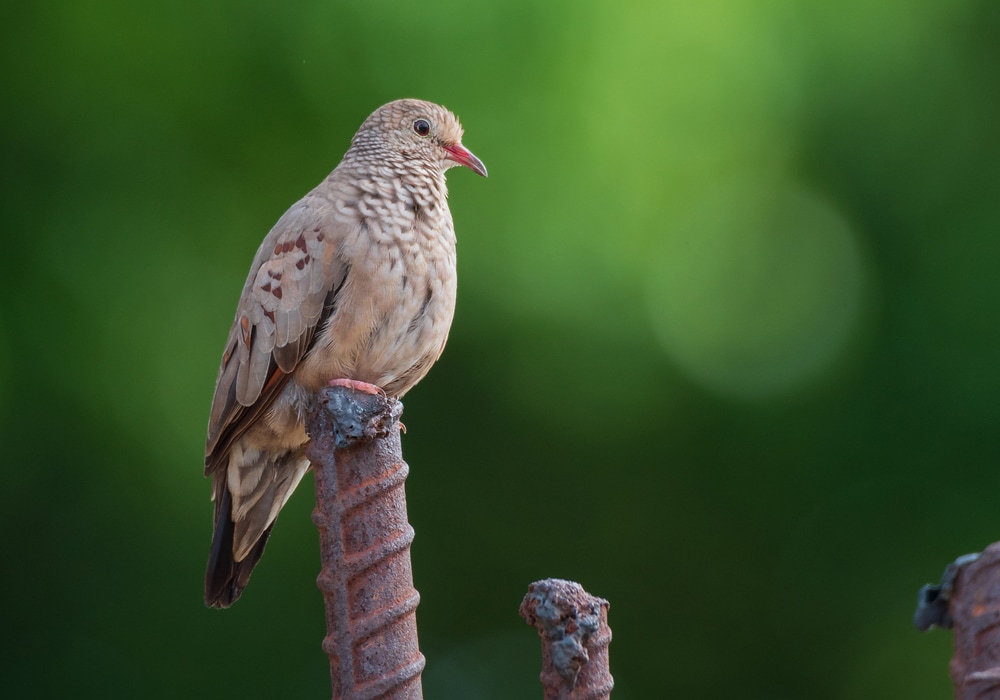
Common Ground-dove is only 6.5 inches (16.5 cm) long, making it the smallest dove in the US. It lives near Gulf Coast beach, including Alabama. You can hear its rising woot-woot in this region during all seasons. However, your chances will be higher in fall and winter since this bird avoids tall grass.
Swallow-tailed Kite (Elanoides forficatus)
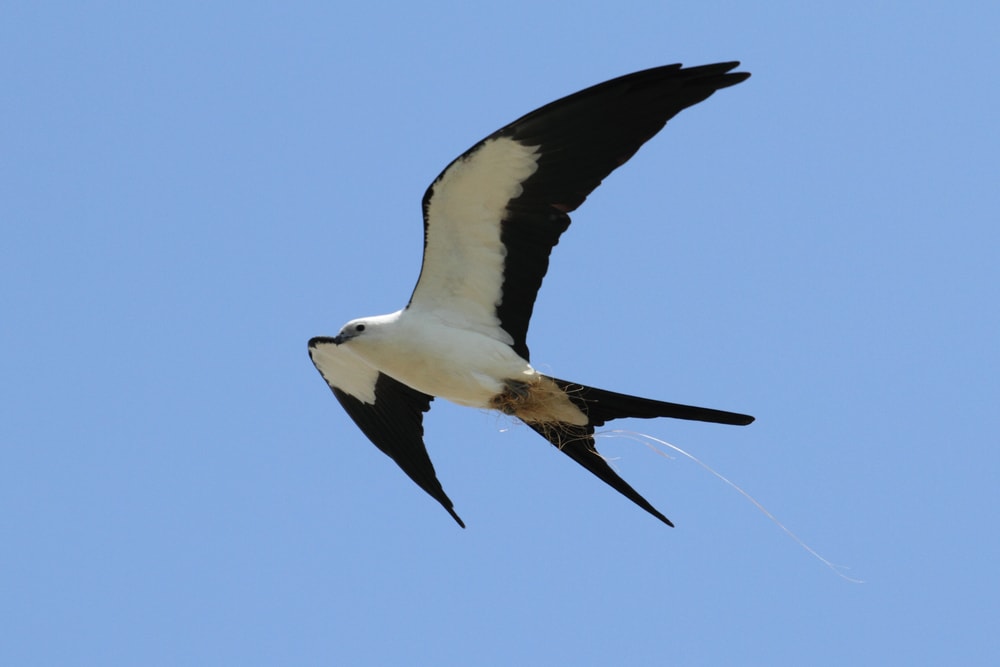
Swallow-tailed Kite is recognizable for its wingspreads of more than 4 feet (1.2 m). This medium-sized trans-gulf migrant spends winters in South and Central America and enjoys summers in the US. You can see these high conservation concern birds in Alabama in breeding areas like Mobile-Tensaw River Delta.
Common Loon (Gavia immer)
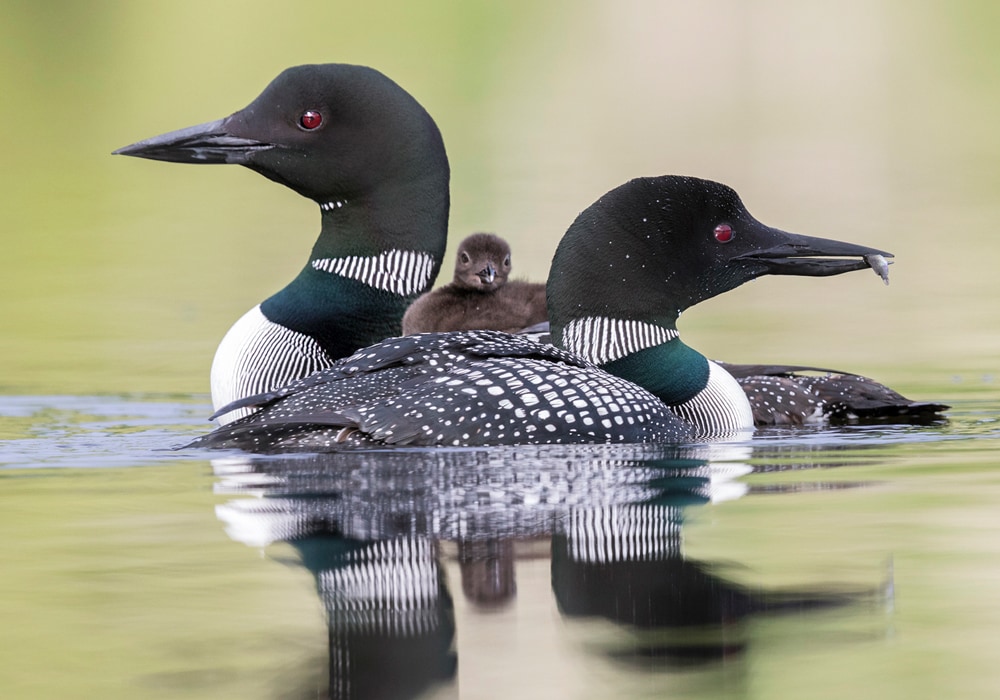
Thousands of wintering Common Loons live on Alabama’s lakes from mid-autumn to early spring and represent an authentic sound of the wilderness. These large, 28 to 30 inches (71 to 76 cm) long water birds of Alabama with grey upperparts and white lower body parts usually choose large spaces for takeoff.
Seaside Sparrow (Ammodramus maritimus)
Medium-sized, 5 to 6 inches (13 – 15 cm) long Seaside Sparrow is closely tied to salt marsh throughout the year, and you should look for it along the coastal part of Alabama. Unfortunately, the Dusky variation recently became extinct, but you can enjoy Cape Sable, discovered in 1918.
Nelson’s Sparrow (Ammodramus nelsoni)
Beautiful light-colored, 4 to 5 inches (10 – 13 cm) long Nelson’s sparrow spends cold winters along the coast and is one of the common birds in Alabama. After the breeding period in Canada, you can spot this beauty in the marshes next to the Dauphin Island airport.
Prothonotary Warbler (Protonotaria citrea)
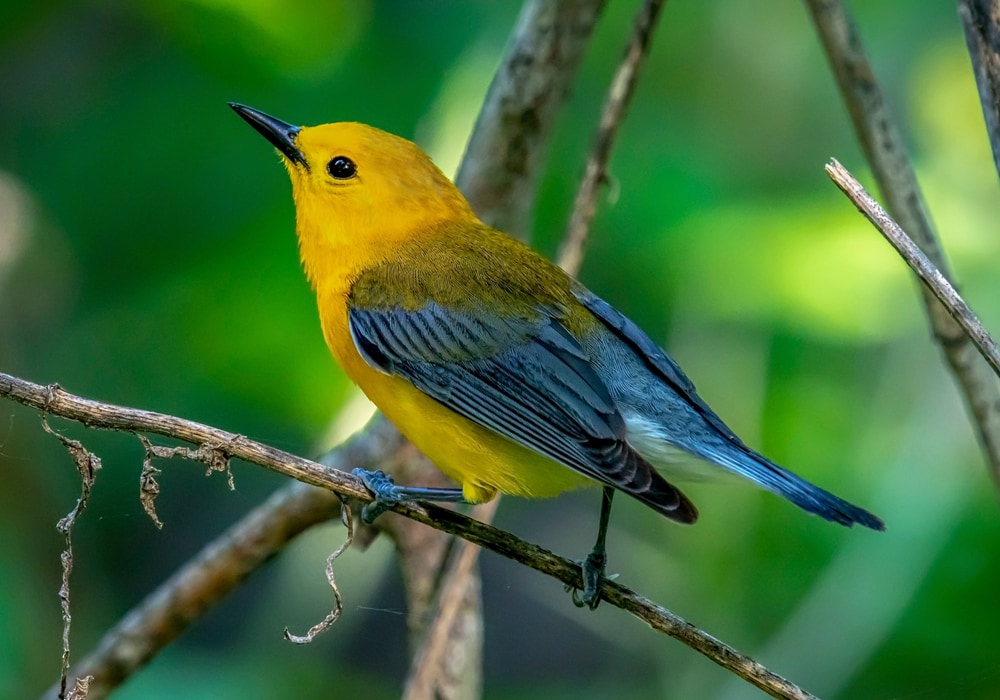
If you look for unique yellow birds in Alabama, a Prothonotary Warbler male is a breathtaking creature that you will adore. This species spends springs and summers, mainly from April to July, in this states’ bottomland forests next to standing water. Currently, it has a moderate conservation concern status.
Hooded Warbler (Setophaga citrina)
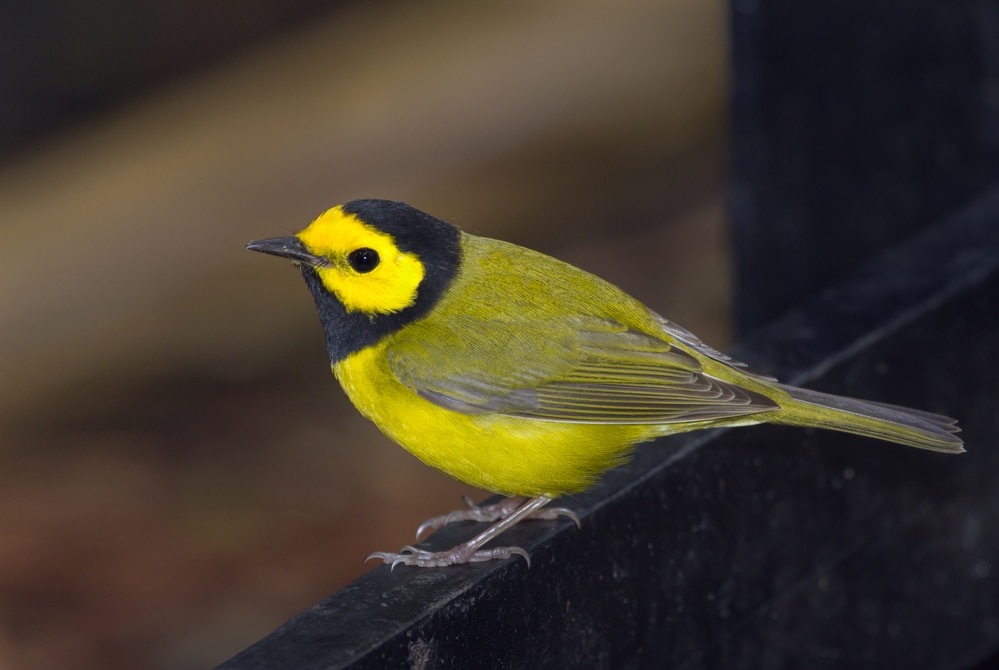
Hooded Warbler is a 5.5 inches (14 cm) long bird recognizable for its yellow underparts, olive green upper body, and flashes of white when fanning its tail. It arrives in Alabama in early spring and stays next to wet swamps’ moist edges and around the Tensaw Delta until late summer.
Brown-headed Nuthatch (Sitta pusilla)
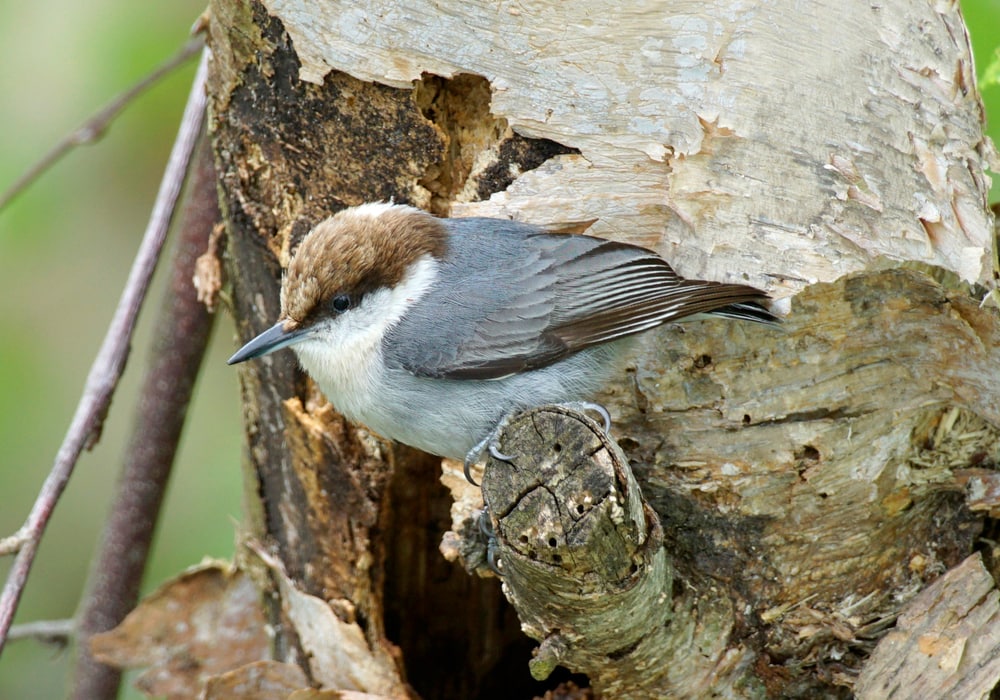
Brown-headed Nuthatches are delightful, 4.5 inches (11.5 cm) long birds of south Alabama that exclusively live on natural growth pines. You won’t have any problem finding these beauties with a unique white spot at the neck’s nape during all seasons. The oldest recorded senior in this state was almost six years old when recaptured in 1960.
Red-cockaded Woodpecker (Picoides borealis)
Approximately 8.5 inches (21.5 cm) long Red-cockaded Woodpecker is highly famous in North America. You can find this bird with a unique red cockade, black crown, and white cheek patch in central Alabama’s National Forests. Unfortunately, its status is of the highest conservation concern due to the drastic longleaf pine ecosystem decline.
Blue Grosbeak (Passerina caerulea)
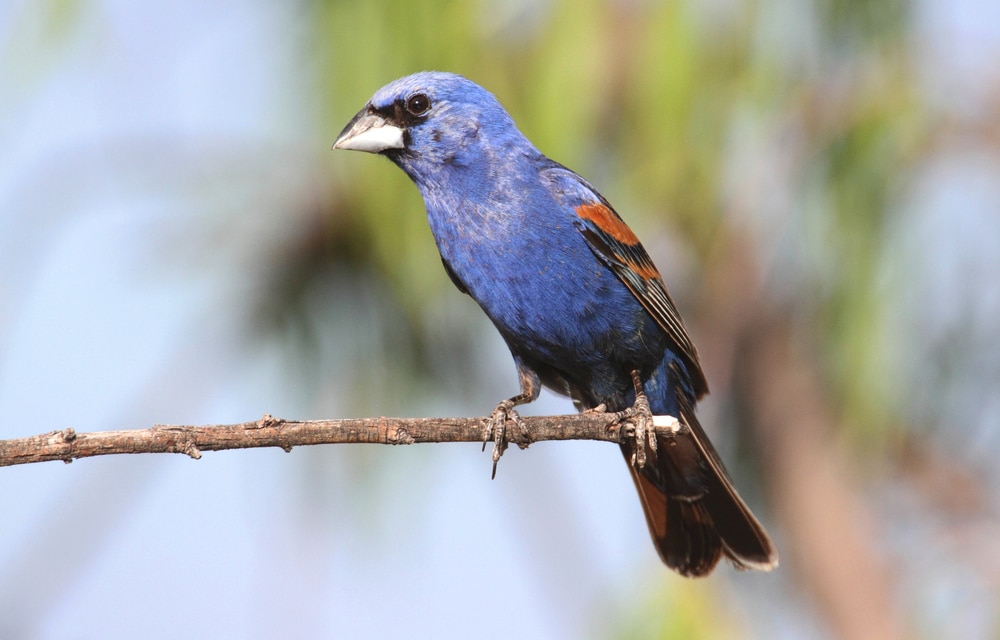
Blue Grosbeak is an Alabama bird living across the whole state during the breeding season from spring to fall. These 5.5 to 7 inches (14 – 18 cm) long songbirds with a large beak are happy with any possible areal except swampy and too urban ones. Males enjoy spreading their tails and showing colorful feathers.
Common Birds of Alabama
This list is based on Ebird recorded views data given by people seeing these birds. Most of them will probably come to your feeders, as well.
Northern Cardinal (Cardinalis cardinalis)
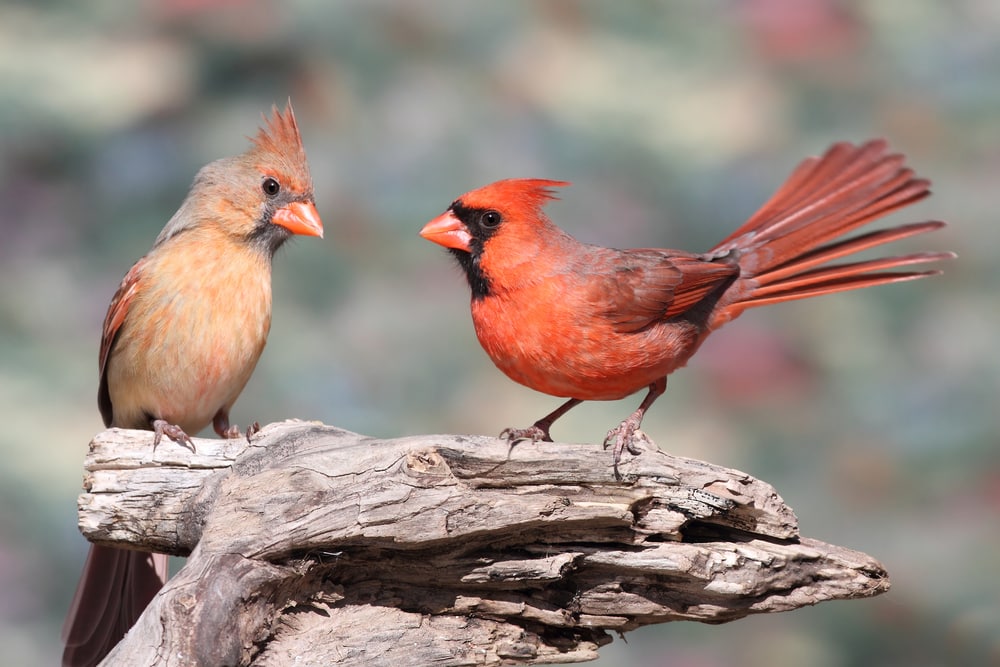
Northern Cardinal is an 8 to 9 inches (20 – 23 cm) long coral red songbird with short wings and a long tail. There are not too many backyard red birds in Alabama, but this one is actually the most common throughout a year, with about 61% frequency.
Mourning Dove (Zenaida macroura)
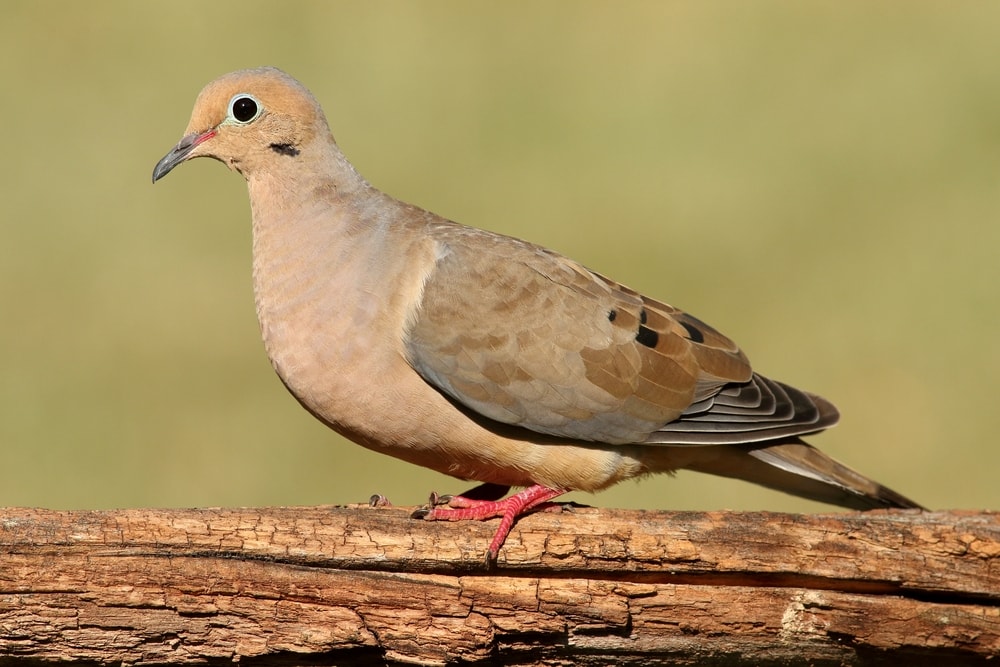
Mourning Dove is a 12 inches (30.5) long brown breeder bird with short legs and dark spots over the back and wings. It is quite common in woods, farmlands, and urban areas of Alabama, and you can see it throughout the year and hear its mournful cooing in spring.
Carolina Wren (Thryothorus ludovicianus)
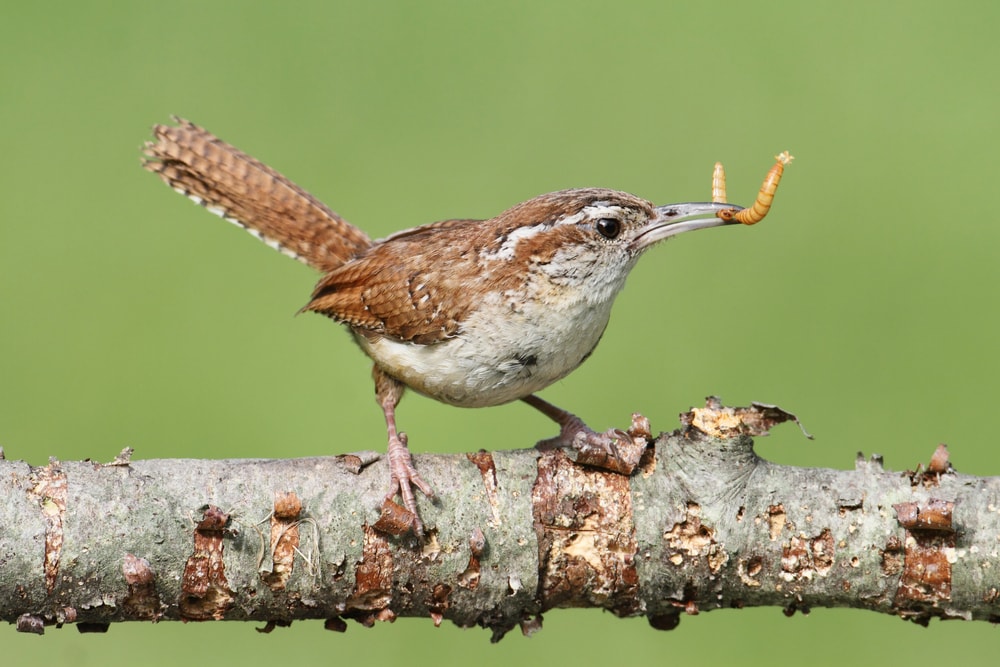
Carolina Wren is a loud, 4.5 to 5.5 inches (11.5 – 14 cm) long rusty-brown backyard bird with a white eye stripe. You can see it in brushy suburban yards and thickets of the southeastern US. Once these lovely birds find partners, it is a lifelong love, and they stay paired for life.
Northern Mockingbird (Mimus polyglottos)
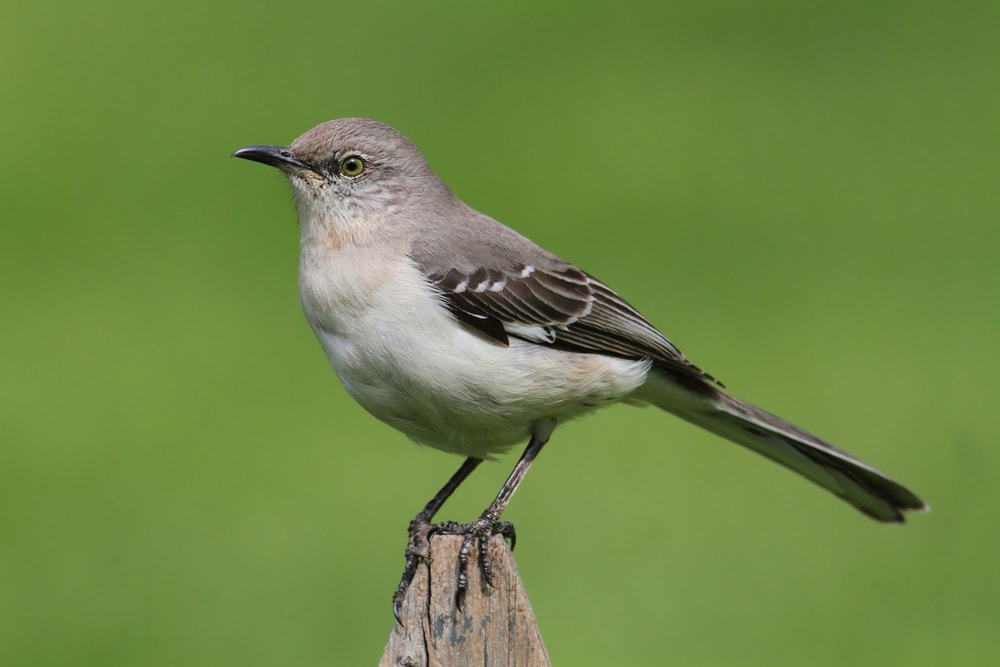
Northern Mockingbird is a grayish-brown, 9 inches (23 cm) long songbird that enjoys singing through the day and night without stopping. It prefers living in edge habitats, residential areas, and parks of the southeast of the US. However, you can see it a bit farther north during the summer.
Blue Jay (Cyanocitta cristata)
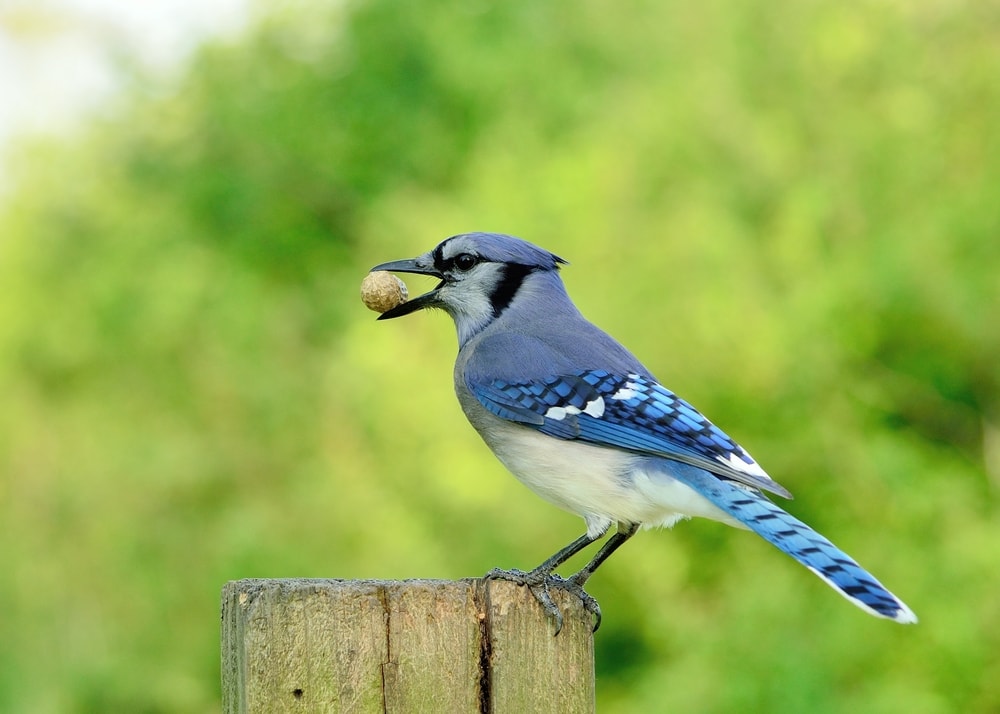
While viewing the album with pictures of wild birds in Alabama, you will undoubtedly notice beautiful, 9 to 12 inches (22 – 30.5 cm) long Blue Jay. This bird with blue feathers is common in Alabama in all seasons. Be careful since it can be quite aggressive toward other feeder birds.
Red-Bellied Woodpecker (Melanerpes carolinus)
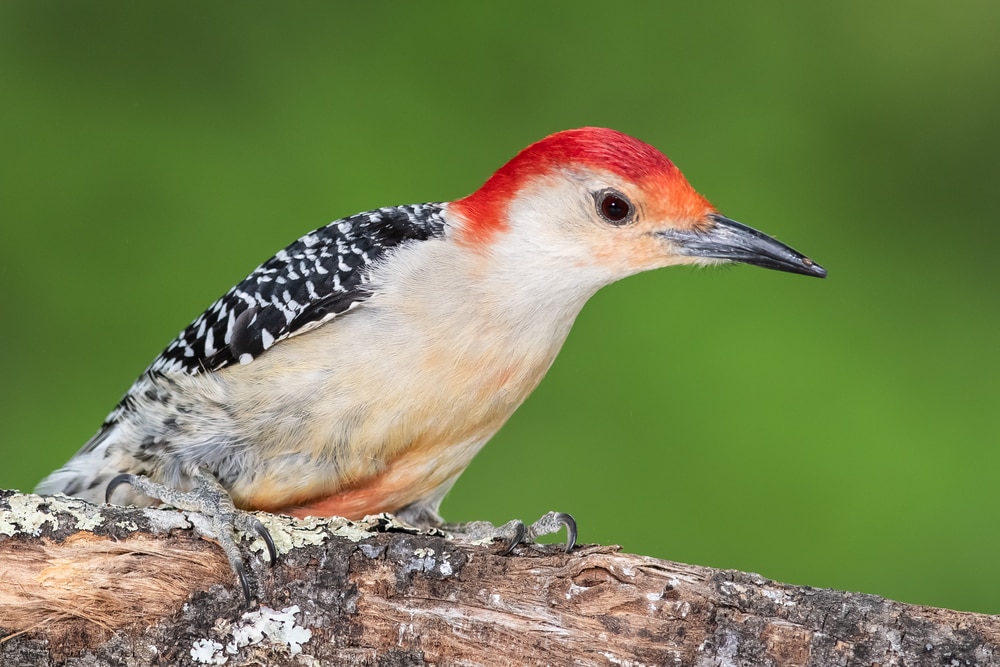
Approximately 9 to 10 inches (23 – 27 cm) long Red-bellied Woodpecker has a 13 to 17 inches (33 – 43 cm) wingspan. That makes it one of the largest backyard birds in Alabama. You can see it in the pine, oak, and hickory woods throughout the year.
Carolina Chickadee (Poecile carolinensis)
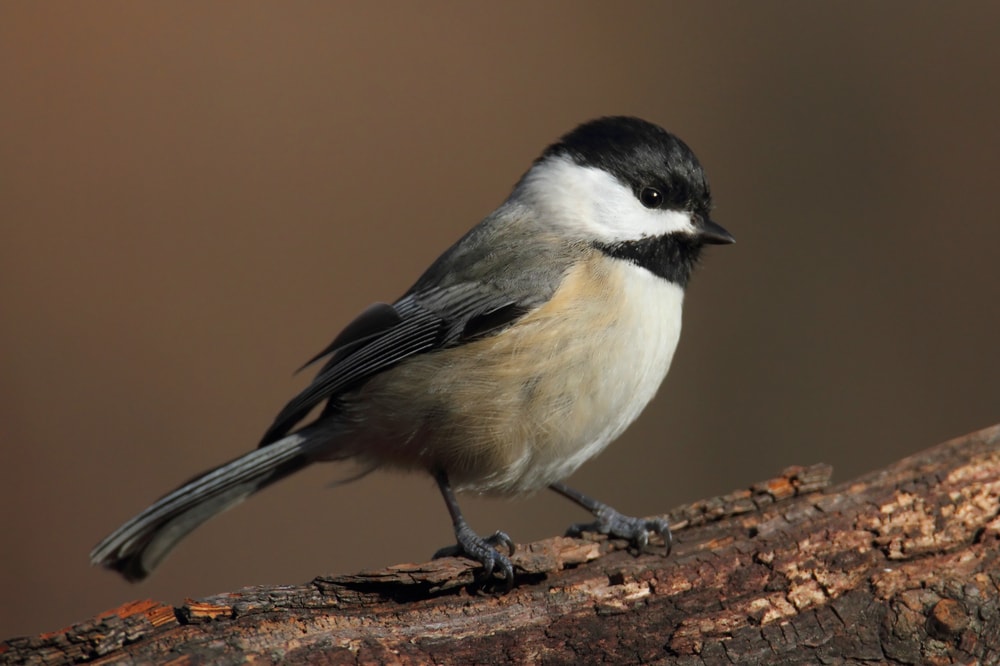
Carolina Chickadee is a small, 4 to 5 inches (10 – 13 cm) long feeder bird with gray feathers above and grayish-white below. Most people enjoy its cheerful, four-note, ‘fee-bee fee-bay’ whistle. You can find this beautiful creature in deciduous forests and even residential areas throughout the year.
Tufted Titmouse (Baeolophus bicolor)
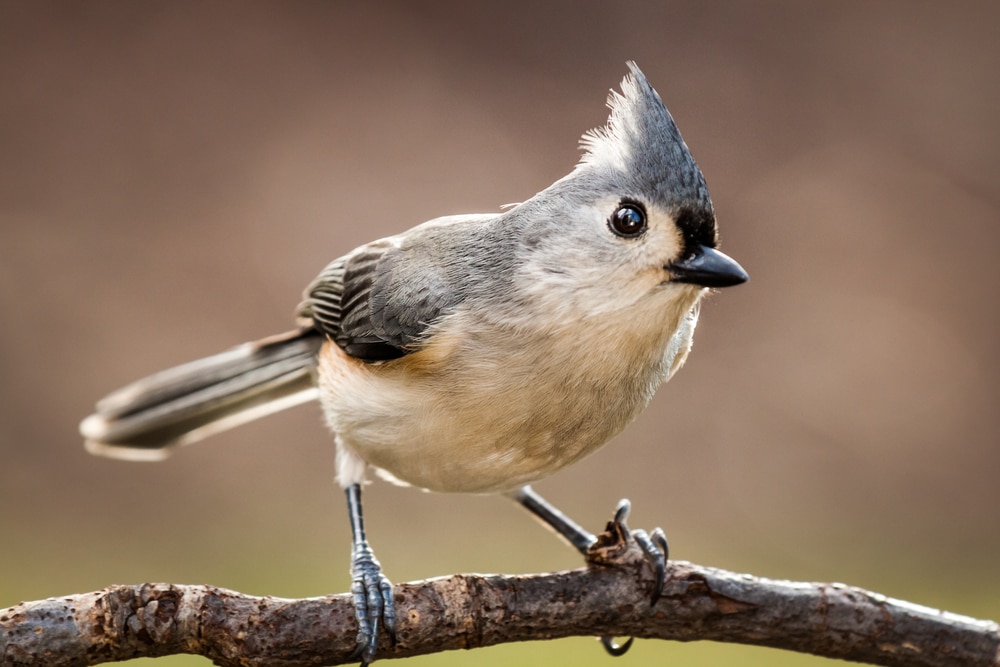
Tufted Titmouse is a 6 to 6.5 inches (15 – 16.5 cm) long bird with a big head and recognizable black feathers around its eyes that underline its size. This breeder prefers eastern and southeastern regions, but it also appears in northern Alabama, thanks to people installing bird feeders in their backyards.
Eastern Bluebird (Sialia sialis)
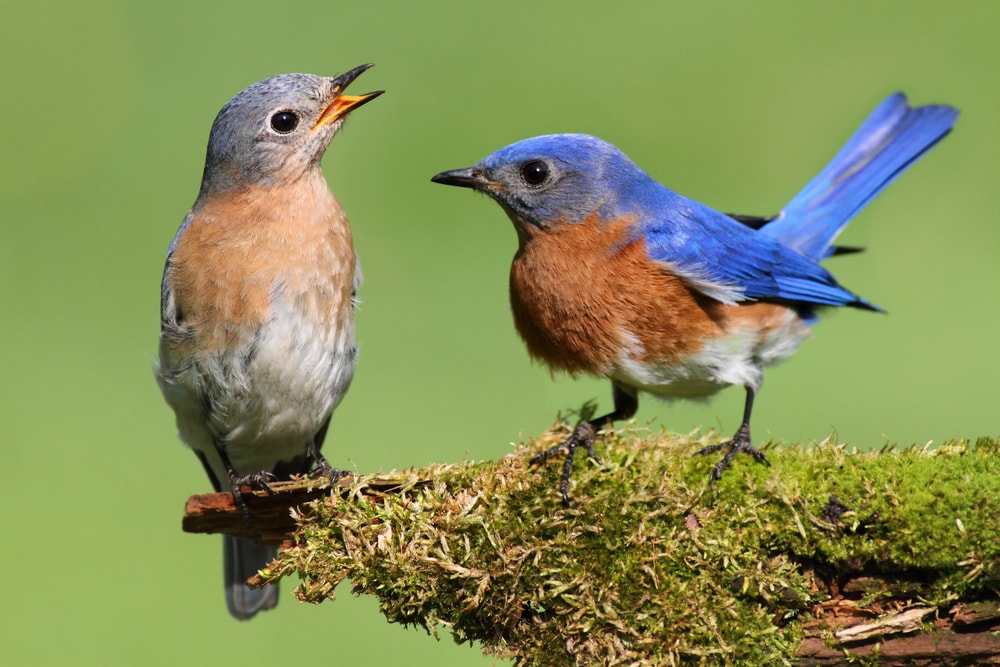
Eastern Bluebird is a tiny, 6.5 to 8.5 inches (16.5 – 21.5 cm) long bird that weighs only 1 ounce (28 g)! You can see it in open fields with rare trees, woodland edges, and even golf courses. It is not rare noticing this orange-blue beauty in the northernmost eastern US in summer.
House Finch (Haemorhous mexicanus)
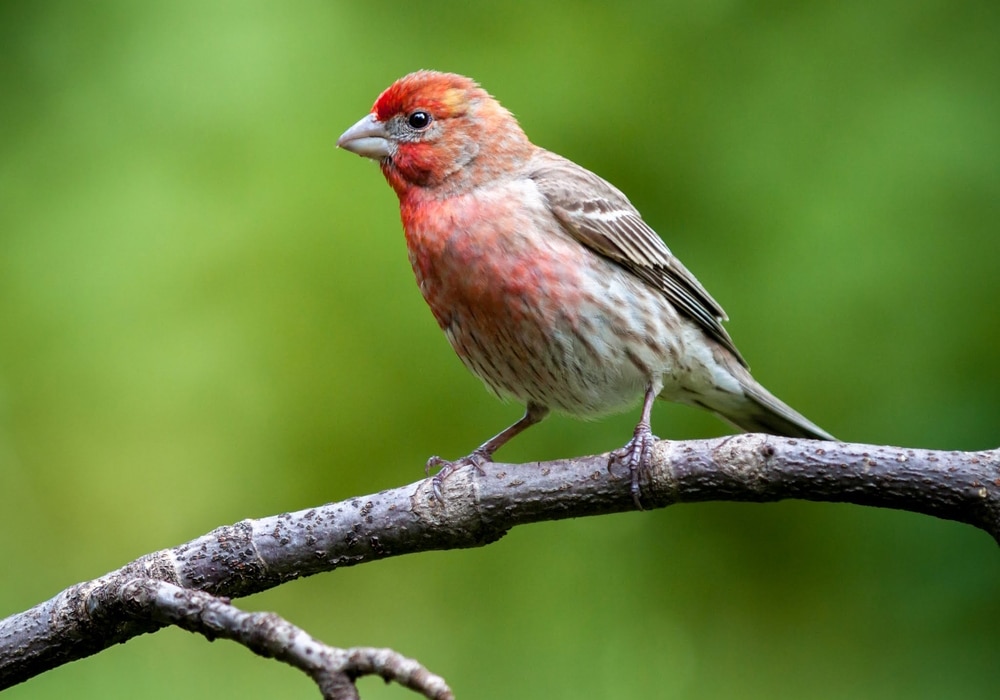
House Finch spends time on the Gulf Coast in all seasons. You can find these 5.5 to 6 inches (14 – 15 cm) long breeder birds in open woodlands and residential areas, mostly gardens throughout the year. Even though males are not territorial, they sing their lively, partly buzzy song wherever they stay.
Alabama Birding Hotspots
There are numerous birding hotspots in Alabama, but some of them are really breathtaking. Pick out the best one based on the season and enjoy Alabama wildlife.
Fort Morgan State Historic Site
Once to reach the end of Fort Morgan Peninsula, about 23 miles (37 km) west of Gulf Shores, you will come to the famous historic site Fort Morgan on Mobile Point. The American Bird Conservancy designated it a ‘Globally Important Bird Area’ during spring and fall migrations. It primarily attracts herons, pelicans, and seagulls.
Dauphin Island Shell Mound Park
If you are a bird lover, you should visit Dauphin Island in April. It is an attractive spot for most migratory birds, including warblers and shiny cowbirds. After a long flight across the Gulf of Mexico, it is their first landing place in spring and the last place to forage before the fall migration.
Dauphin Island Audubon Bird Sanctuary
With protected maritime forest and marshes, the Dauphin Island Audubon sanctuary is one of the top locations for enjoying spring migrations. You can see almost 95% of all birds documented in Alabama here, including neotropical migrants like herons and egrets. Therefore, it is not surprising that this place is well-known as America’s birdiest city.
Dauphin Island Fort Gaines
Fort Gaines guarded the Mobile Bay entrance for over 150 years. Nowadays, it is an attractive historic site on Dauphin Island that offers a breathtaking view of the Gulf of Mexico. It is worth birding in this magical place for a few hours and exploring the island habitat that provides a home for numerous wildlife.
Wheeler NWR Blackwell Swamp (NABT 26)
Come to explore Blackwell Swamp, forested bottomland with an attractive lake, in Wheeler National Wildlife Refuge. If you are a dedicated bird lover, you will enjoy the company of Green Herons. Explore the nesting habitat for Red-bellied Woodpeckers and Red-headed Woodpeckers at the north, or look for Kentucky Warblers nesting in the swamp.
Wheeler NWR White Springs Dike (NABT 20)
If you are lucky to get here, you will enjoy the premier birding site in Tennessee River Valley, Alabama. You will have an excellent view of shorebirds and waterfowl anywhere along the dike. Then, go to wood to search for diverse neotropical migrant species, especially Yellow Warblers nesting in the area.
Wheeler NWR Limestone Bay/Arrowhead Landing (NABT 23)
Located on Limestone Bay, Arrowhead Landing is a fertile reservoir with an outstanding view of the bay. This place offers an unobstructed view of open water with numerous bird species, including Common Loon and Lesser Scaup. When the water is low, you can also see migrant shorebirds or hear Belted Kingfisher while flying over the location.
Eufaula NWR
You can come here year-round, but the best time for birding is during fall and winter, especially if you enjoy Sedge Wrens, Sandhill Cranes, wetland songbirds, sparrows, and ducks. On the other hand, it is an ideal place for a summer visit when you want to explore waders and grassland bird species.
Bon Secour NWR
This National Wildlife Refuge in Gulf Shores is a home for at least 360 bird species. The ideal time for visiting is during spring and autumn when you can see numerous migratory birds. Winter is an excellent period for exploring American Kestrel, Common Loon, and Snowy Egret, but many species live there year-round.
Swan Creek WMA
This fantastic area on the Tennessee River is a home for numerous waterfowl, especially in fall when you can see flocks of shorebirds over mudflats. Except for typical species like killdeers and yellowlegs, you can also spot migrant passerines or unusual birds, including American Avocets, Baird’s Sandpipers, and Black-bellied Plovers.
Bayfront Park/Village Point (Daphne)
Village Point Park is the largest park in Daphne city, well known for numerous resident bird species, including Brown Pelican, Red-bellied Woodpecker, and regular migrants. You can also find some rarities coming here for a few days, so it is necessary to be patient to enjoy such a great privilege.
Alabama Birds Field Guides
Since hundreds of birds live in Alabama, you will need an excellent field guide to help you find a particular bird. Although you have an adequate app on your smartphone, this book is an affordable option full of valuable information and without a battery that often dies at a crucial moment. Let’s find the best one.
Birds of Alabama Field Guide

Birds of Alabama Field Guide illustrated in 2006 will make birds of Alabama identification entirely effortless. Writer, naturalist, and wildlife photographer Stan Tekiela did an excellent job and described 140 bird species organized by color. That makes this book an unavoidable guide for everyone planning to birdwatch in this state.
Birds of Alabama: Accompanies the Birds of Alabama Field Guide
If you like a Birds of Alabama Field Guide, you will adore this set with an audio CD that offers an Alabama birds list with astonishing 120 minutes of bird calls. Thanks to Stan Tekiela’s digital recordings and detailed descriptions, you will effortlessly recognize any bird you are interested in.
A Guide to the Birds of the Southeastern States

John h. Rappole wrote the best US region’s birds of Alabama field guide with photographs and each bird’s distribution map. This dedicated birdlife researcher reveals over 190 bird habitats in four southeastern states to look for and describes 376 species to make it easier for you to identify each of them effortlessly.
Alabama Bird Checklist
Officially, the Alabama bird checklist from October 2020 includes 449 species, including 158 accidentals, six introduced to the state, 13 documented but without physical evidence, three extinct, and one extirpated. If you live in this state or plan to explore fantastic birds native to Alabama, you can download this handy bird checklist and start birding.
Download FREE Alabama Bird Checklist PDF
Click here for the overview of Alabama birds
Specific Bird Species
Besides the common bird species, you can find some specific and rare birds in Alabama or even come to the northern Gulf and enjoy pelagic birding from April to October.
Bluebirds in Alabama
You can find five bluebird species in the Gulf Coast region, Alabama. Four of them live here year-round, including Blue Jay and Eastern Bluebird and a large Great Blue Heron and Blue-gray Gnatcatcher, breeders found in forest edges. Besides, you can spot attractive Indigo Bunting during spring, summer, and fall.
Finches in Alabama
Eight seed-eating passerines live in Alabama, including House Finch, a beautiful native species to the southwestern and American Goldfinch, a yellow breeder common year-round in Tennessee Valley. When coming to the Gulf Coast region in spring, fall, and winter, you can see a remarkable Purple Finch in a coniferous forest.
Woodpeckers in Alabama
Woodpeckers are small birds tapping noisily on tree trunks, which are difficult to identify due to numerous similarities. You can determine nine of them in Alabama, including the Red-bellied Woodpecker, the most common species in all seasons, Alabama’s state bird Northern Flicker (yellowhammer), and the Red-cockaded Woodpecker, the only endangered in this state.
Owls in Alabama
The medium-sized Barn Owl with a typical heart-shaped face is the most widespread land bird worldwide, and you can see it in all 67 Alabama counties. Besides, three other species, including Great Horned Owl and Screech Owl, are native to Alabama, but you can see them only at the Alabama Wildlife Center.
Hummingbirds in Alabama
Tiny hummingbirds are migratory birds capable of hovering in mid-air and fly backward. They usually travel 2,000 miles (3,220 km) to wintering grounds across the Gulf of Mexico. The Ruby-throat is the most common in Alabama among fourteen different hummingbirds found in this state. Lucky bird lovers occasionally manage to see the rare Rufous Hummingbird.
Hawks in Alabama
There are sixteen birds of prey in Alabama, including eagles, harriers, kites, Old World vultures, and two hawk types (buteo and accipiter). Not all seven hawk species live here year-round. Northern Harriers come here in winter, while you can see the smallest Broad-winged Hawks during their fall migration to Central America.
Vultures in Alabama
New World vultures are scavengers. The Black Vultures are common birds of north Alabama, and you can see these breeders in spring, summer, and autumn. On the other hand, Turkey Vultures are the New World’s most widespread vultures in the US and usually migrate to the south during the winter.
Wrens in Alabama
These small birds are relatively inconspicuous, but you can recognize them thanks to loud melodious singing. It is possible to see seven Alabama types, including common Carolina Wren that lives on rocky slopes throughout a year. You should come to Alabama in winter to enjoy winter wrens that migrate from the north to spend cold days here.
Ducks in Alabama
Most of the duck types you can see in Alabama migrate from the Great Lakes and Prairie Pothole regions. Except for native birds, you can also look for accidental ones, including Trumpeter Swan, one of the rarest white birds in Alabama. Come here in winter to see Mallard, the ancestor of almost all duck breeds.
Falcons in Alabama
No matter which part of Alabama you visit, you can find one of five falcon types nearby, including Peregrine Falcon, the fastest bird worldwide, reaching an unbelievable 200 mph (322 km/h). It is worth hearing a distinct call of American Kestrel, the smallest Alabama falcon, or seeing unpredictable fierce Merlin that are not common to observe.
FAQ
What kind of birds live in Alabama?
According to the official Alabama Ornithological Society, there are 449 species on the list of birds in Alabama, including breeders and exotic species, and those migrating through the state.
What is the most common bird in Alabama?
With about 61% frequency, long-tailed, 8 to 9 inches (20 – 23 cm) long Northern Cardinal is the most common bird living in Alabama throughout the year.
Why is Yellowhammer Alabama’s state bird?
Yellowhammer is a symbol of Southernness and the state bird of Alabama in honor of Confederate troops from this state wearing yellow uniforms during the Civil War.
What is the Alabama state bird?
In homage to the soldiers fighting in the Civil War, the Northern flicker officially became an Alabama state bird on September 6, 1927, based on Gov. Bibb Graves’s decision.
Are there falcons in Alabama?
Yes, you can find falcons, beautiful birds of prey in Alabama, including Pigeon Hawk, Osprey, Northern Harrier, rarely seen Peregrine Falcon, and the smallest, American Kestrel.
Are there eagles in Alabama?
Yes, you can see Bald Eagles all over Alabama, but mostly along rivers and lakes, while Golden Eagles prefer inhabiting areas with plenty of food, primarily near pastures and grasslands.

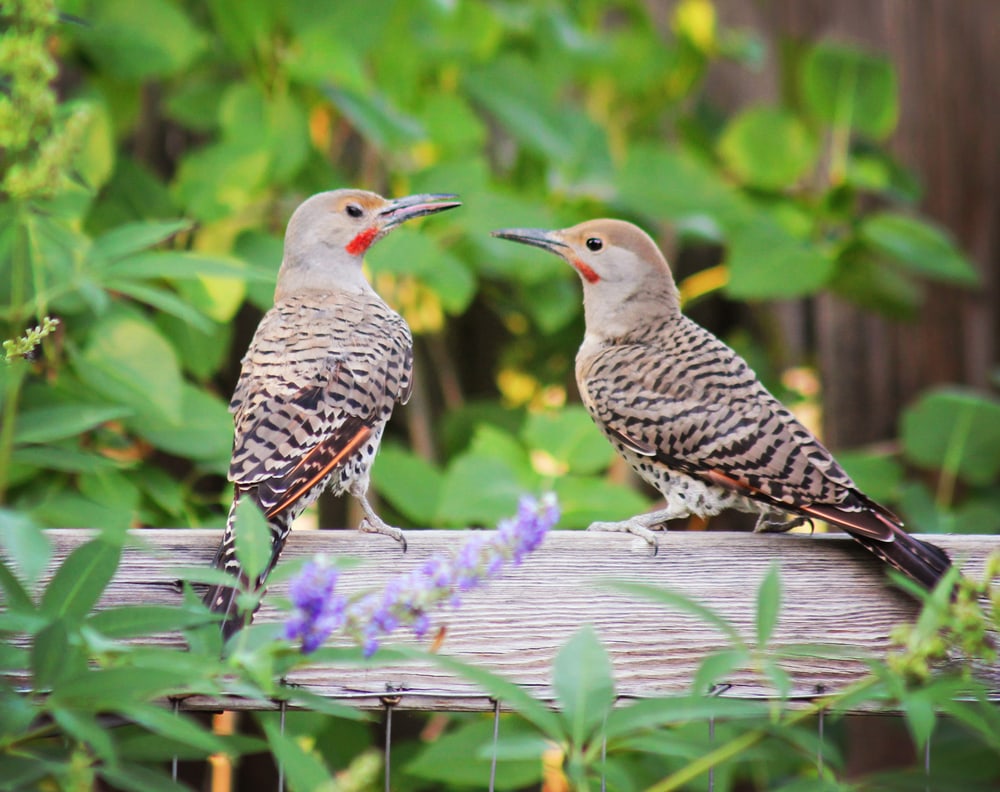
You omitted the Barred Owl. They definitely reside in Lauderdale County near property I own there. I am hoping to encourage their presence on my property in Colbert County.
There are two types of swallows in my area. One is split tailed and the other rounded tail. The split tailed one is mostly dark but the other is dark on top and light on bottom. They both are very fast and rarely land so it’s hard to observe them but they intermingle catching bugs as they fly (there is a small lake behind my house. Can you identify? Thanks
Is there a list of birds that migrate through NW Alabama? It’s February 25th and I’m seeing flocks of birds (e.g. robins) that I assume are “passing through”.
Thanks, Dan